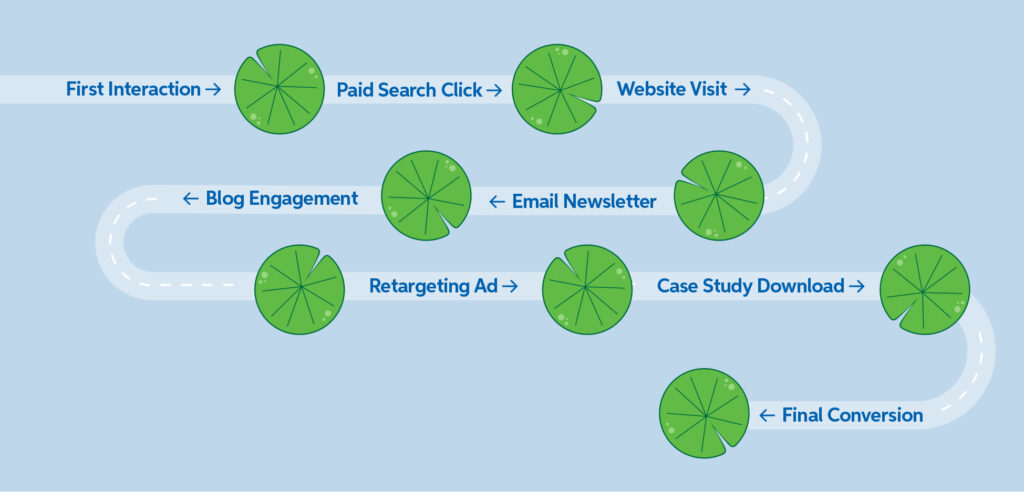Understanding the journey a customer takes with your brand—from their initial interaction to the moment they make a purchase or reach out for more information—has become essential in multi-channel marketing. With so many touchpoints available, customers don’t convert after just one interaction; they’re likely seeing and interacting with your brand across multiple channels over time. That’s where multi-touch attribution marketing becomes essential, redefining how you measure marketing efforts and plan your next move.
Let’s explore how multi-touch attribution works, the different attribution models, and the benefits multi-touch attribution marketing can offer in shaping data-driven strategies.
What is Multi-Touch Attribution Marketing?
Multi-touch attribution (MTA) is a marketing strategy that assigns value to multiple customer touchpoints that lead to a conversion. It steps away from older models, which credit just one channel, and instead provides a more dynamic, accurate understanding of how each interaction moves a customer closer to conversion.
In essence, multi-touch attribution looks beyond the question, “Which channel made this sale?” and instead asks, “How did each channel contribute to this sale?” Whether a prospect discovers you through a paid search ad, engages with a blog as part of your inbound marketing process, follows your brand on social media, or clicks on an email, each touchpoint is recognized. MTA gives marketers a holistic view of the customer journey, allowing for data-driven optimizations across every channel.

How Does Multi-Touch Attribution Marketing Work?
Multi-touch attribution gathers data from all interactions between your brand and a prospect and then assigns value to each touchpoint in the conversion path. Marketers can then use these insights to adjust campaigns, optimize budget allocation, and improve overall channel performance. With multi-touch attribution, you can get granular insights into the touchpoints that matter most to your customers. However, you need a robust attribution model that aligns with your goals to make this work effectively.
What’s the Difference between Single-Source Attribution & Multi-Touch Attribution Models?
Attribution models are frameworks for assigning credit to various interactions in a customer’s journey. Traditionally, many businesses have used single-source attribution models, which give all the credit to just one interaction point: the first touch (where a customer learns about your brand) or the last touch (the final interaction before conversion). While these models are straightforward, they tend to oversimplify the customer journey.
First-Touch Attribution
This model attributes all conversion credit to the first touchpoint in the journey. It helps marketers understand how prospects discover your brand but overlooks the importance of subsequent interactions. For instance, a customer might initially discover your company through social media, but without recognizing later interactions like email or retargeting ads, you lose insight into how those channels influence conversions.
Last-Touch Attribution
The last-touch model assigns full credit to the final interaction before conversion, such as an email click or a retargeting ad. While helpful for identifying which channels close sales, it fails to capture the role of earlier efforts in building awareness and nurturing the lead.
Both first-touch and last-touch models provide limited perspectives, as they ignore the influence of other interactions along the way. In a multi-channel world, the customer journey is often nonlinear and multi-layered, requiring a more comprehensive view.
Multi-Touch Attribution Models
Unlike single-source models, multi-touch attribution marketing considers every touchpoint along the customer journey. This approach offers a nuanced understanding of how each channel contributes to conversions, from the first interaction to the last. Multi-touch attribution provides options for assigning credit across touchpoints, whether by weighting all equally, emphasizing early or late interactions, or highlighting critical milestones like lead generation and conversion. This broader view helps marketers optimize spending across channels and enhance overall campaign effectiveness.
Each multi-touch attribution model offers unique insights into how various touchpoints contribute to conversions.
Linear Attribution
This model distributes equal credit to all touchpoints in the buyer’s journey. For example, if a customer interacts with five different channels before converting, each channel would receive 20% of the credit. Linear attribution is ideal if all channels are equally important to your strategy, but it may lack the nuance of other models.
Time-Decay Attribution
Time-decay models assign more credit to touchpoints that occur closer to conversion. If a touchpoint happened just before the conversion, it will receive more credit than one that occurred earlier. This model benefits long sales cycles where recent touchpoints are often more influential.
U-Shaped Attribution
This model assigns greater weight to the first and last touchpoints, with less weight to interactions in between. It’s a good choice for initial engagement and final conversion strategies. The U-shaped model is often favored in lead generation, as it acknowledges the importance of discovery and closing.
W-Shaped Attribution
W-shaped attribution is similar to the U-shaped model but adds additional credit to a middle touchpoint, often a lead qualification event like a form submission. This model is ideal to emphasize key conversion milestones in a longer journey.
Data-Driven Attribution
For brands looking to move beyond these traditional attribution models, data-driven attribution and custom attribution offer powerful, tailored insights. These advanced models allow marketers to determine the actual value of each touchpoint, helping optimize campaigns with precision.
Data-driven attribution (DDA) uses machine learning to assign credit dynamically based on real customer behaviors. Unlike standard models, which apply fixed rules, DDA analyzes historical data to learn which touchpoints are most influential in conversions. As customer behavior changes, DDA adapts, making it especially effective in complex or evolving campaigns. With DDA, you can uncover channels that may not drive direct conversions but play an important supporting role, helping you allocate budget more effectively across the funnel.
Custom Attribution
Custom attribution gives brands complete control over how credit is assigned to different touchpoints. Rather than relying on pre-set models, marketers can design a model that matches their unique customer journey, weighting specific interactions like form submissions or product page views based on their importance. This approach is ideal for businesses with highly specific goals, allowing them to prioritize touchpoints that align closely with their strategy. While more labor-intensive, custom attribution enables a personalized view of campaign performance and offers unique insights for brands with niche or unconventional customer paths.
Choosing the right multi-touch model depends on your goals and the specifics of your customer journey. The advantage of multi-touch attribution marketing is that you’re not limited to one model—you can experiment to see which model provides the most accurate insights into your campaigns.
What Are the Benefits of Multi-Touch Attribution Marketing?
Multi-touch attribution enables marketers to analyze the whole customer journey and make informed decisions about each marketing channel’s value. This holistic approach changes the game and offers a number of benefits.
More Accurate Performance Insights
With multi-touch attribution, you’re no longer making decisions based on incomplete data. Instead of focusing on how one channel performs, MTA lets you see how every channel interacts and supports conversions in a cohesive environment.
Better Budget Allocation
By understanding the actual role of each touchpoint, you can allocate budgets more effectively. For instance, if paid search isn’t driving conversions directly but contributes significantly to awareness, you can justify investing in it as a top-of-funnel strategy.
Refined Strategy Across the Funnel
Multi-touch attribution reveals which channels work best at each stage of the funnel, allowing you to tailor strategies that nurture prospects from awareness to conversion.
Improved ROI
You can optimize your spending and maximize returns when you have accurate data about which touchpoints drive conversions. Instead of scaling back on a channel because it doesn’t drive immediate conversions, MTA shows you how it plays a part in the bigger picture.
Customer-Centric Marketing
By aligning your marketing strategy with the actual paths your customers take, multi-touch attribution helps you create a more customer-focused approach, ensuring you’re meeting them with the right content at the right time.
Multi-touch attribution helps marketers embrace the reality that no single channel drives conversions on its own. It’s often a mix of touchpoints that brings prospects to the point of conversion, and seeing the whole journey provides a competitive advantage in refining strategies for higher returns.
Implementing Multi-Touch Attribution
If you’re ready to leverage multi-touch attribution marketing, implementing it requires careful planning and robust analytics tools. Here’s how to get started:
- Define Your Goals and Metrics: Clarify what you want to achieve, whether tracking conversions, measuring return on ad spend (ROAS), or lowering customer acquisition cost (CAC). This will guide your selection of attribution models and the insights you aim to generate.
- Select the Right Attribution Model: Each attribution model offers different insights, so select one that best aligns with your business goals and customer journey. You can even start with a linear model and experiment with other models as you gather more data.
- Use Data and Analytics Tools: Multi-touch attribution requires a robust analytics tool capable of tracking customer interactions across various channels. These tools provide the data necessary to implement and optimize your attribution strategy.
- Optimize Based on Insights: Once you’ve implemented multi-touch attribution, review the insights regularly. Look at which channels assist conversions, which channels close conversions, and which might need more support. Use these insights to refine your strategy and improve campaign performance.
Bringing It All Together
Multi-touch attribution gives marketers a comprehensive view of customer journeys, revealing the nuanced interactions that lead to conversions. Adopting a multi-touch approach can help you understand how each marketing channel contributes to your goals, optimize your spending, and drive more effective campaigns.
This holistic approach isn’t just about maximizing your budget; it’s about aligning your marketing strategy with your customers’ experiences. Embracing multi-touch attribution can help you make informed, data-backed decisions that build a more effective marketing strategy that keeps the bigger picture in focus and ultimately drives growth.
Ready to explore the possibilities of multi-touch attribution for your brand?
Contact our team today to learn how Sagefrog can help you harness the power of multi-touch attribution and elevate your marketing strategy.







